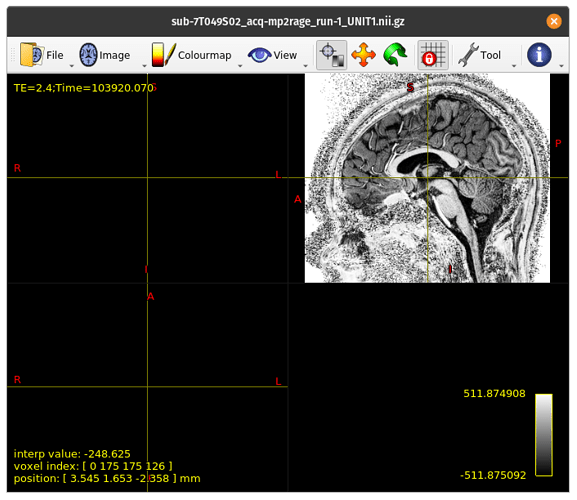I have some Philips data (7T) which tricks dcm2niix in the DICOM-to-NIfTI-conversion.
This is a sag MP2RAGE image that is reconstructed on the scanner. When converting it, the SS-direction along the 4th dim but corrupts the voxel sizes.
************************************************
Image name: "sub-7T049S02_acq-mp2rage_run-1_UNIT1.nii.gz"
************************************************
Dimensions: 1 x 352 x 352 x 257
Voxel size: 0.7 x 0.639788 x 0.639788 x 0.0068
Data strides: [ 4 -1 2 3 ]
Format: NIfTI-1.1 (GZip compressed)
Data type: signed 16 bit integer (little endian)
Intensity scaling: offset = -511.87509155273438, multiplier = 0.25
Transform: 0.9997 0.00486 0.02455 0.2514
1.397e-09 0.981 -0.1942 -86.44
-0.02503 0.1941 0.9807 -133.9
comments: TE=2.4;Time=103920.070
Well, the same goes for mrconvert directly on the DICOM
mrconvert s1309_WIP_-_imag - | mrinfo -
mrconvert: [done] scanning DICOM folder "s1309_WIP_-_imag"
mrconvert: [100%] reading DICOM series "WIP - imag"
mrconvert: [100%] copying from "7T049109 (20211014) [MR] WIP - imag" to "/tmp/mrtrix-tmp-k2y2yl.mif"
************************************************
Image name: "/tmp/mrtrix-tmp-k2y2yl.mif"
************************************************
Dimensions: 1 x 352 x 352 x 257
Voxel size: 0.7 x 0.639788 x 0.639788 x ?
Data strides: [ 4 -1 -2 3 ]
Format: Internal pipe
Data type: unsigned 16 bit integer (little endian)
Intensity scaling: offset = -500, multiplier = 0.2442
Transform: 0.9997 0.00486 0.02455 0.2514
8.635e-10 0.981 -0.1942 -86.44
-0.02503 0.1941 0.9807 -133.9
EchoTime: 0.002392
FlipAngle: 5
PixelBandwidth: 422
RepetitionTime: 0.0068
command_history: mrconvert s1309_WIP_-_imag - (version=3.0.3-52-gd7475aaa)
comments: 7T049109 (20211014) [MR] WIP - imag
study: MR HJ�RNA [ ORIGINAL PRIMARY DERIVED_FFE DERIVED FFE ]
DOB: 14/10/2021
DOS: 14/10/2021 10:38:57
dw_scheme: 0,0,0,0
[257 entries] 0,0,0,0
...
0,0,0,0
0,0,0,0
mrtrix_version: 3.0.3-52-gd7475aaa
I have tried various mrconvert tricks but cannot get this into a 3D volume with correct dimensions and correct orientations. The faulty pixdim3=0.068 keeps dragging along.
Any advice?
Cheers,
Finn

